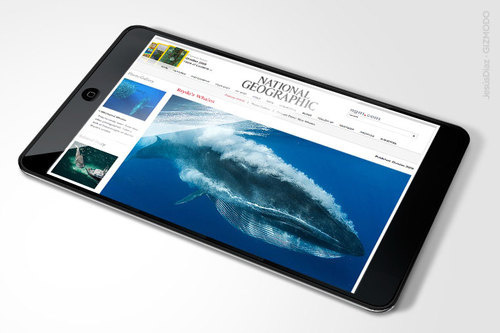Larger and smaller iPhone screens make sense

AppleInsider reports that Apple may be considering larger and smaller displays for its iPhone line. Above is a Gizmodo pre-iPad concept that could resemble Apple's larger-screen iPhone offering.
Kaufman Brothers analyst Shaw Wu citing sources familiar with sources in Apple's overseas supply chain states that the company is working on new iPhone models with both larger and smaller touchscreens. He said those products could launch in 2011, and on carriers other than the currently exclusive AT&T. Verizon Wireless has been long-rumored to be getting the iPhone with recent rumblings suggesting that it will finally happen January 2011.
Our sources believe these likely represent new high-end and low-end iPhone models to complement its current iPhone 4... One possibility we are picking up is a "mini" or "nano" iPhone with a smaller candybar form factor leveraging technology in its new mini touchscreen iPod nano.
Following is an older concept photo of what the iPhone mini or shuffle could look like:
While I don't think that the Apple offering will be quite as dramatic as the concepts above (the iPhone shuffle makes almost no sense) there's certainly a case to be made for diversifying the iPhone product lineup. The iPhone's 3.5-inch screen is a one-size-fits-all product that increasingly doesn't necessary fit the needs of the widest possible audience of mobile phone users.
A larger iPhone -- with say a 4.3-inch display -- could allow Apple to better compete with larger-screen Android handsets like the Droid X and Evo 4G. A larger-screen iPhone would also appeal to the high-end market and to users that view a lot of photos and videos as well as users with poor eyesight.
Apple could even differentiate the "high-end" iPhone model by offering it exclusively with a Retina Display -- obviously at a higher price.
A smaller, say 3.1-inch display, could arrive in an iPhone a couple of different ways:
It could end up in smaller form-factor iPhone (like the iPhone nano concept above) for users that prefer a smaller device. This would also allow Apple to offer a lower-price iPhone ($99, anyone?) that would appeal to price sensitive customers.
Alternatively, a smaller-screen could allow the iPhone to include a hardware keyboard (like the new Droid Pro) that could attack the Blackberry's sweet spot -- hardcore email users that demand a physical keyboard.
New iPhones are traditionally released in the summer, but Wu notes that progress is being made on these new models and they are rumored to be far enough along to arrive as soon as the first half of 2011 -- and even as early as the first quarter of next year.
What do you think? Would you prefer a larger or smaller-screen iPhone?
Images: Gizmodo and InformationArchitects
